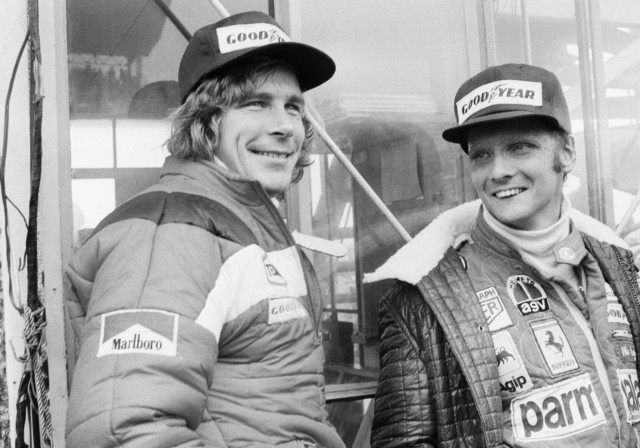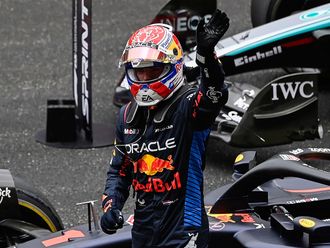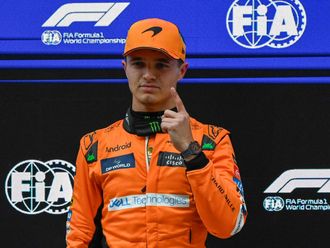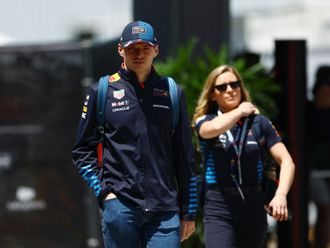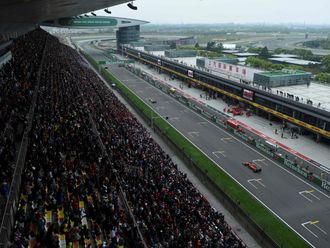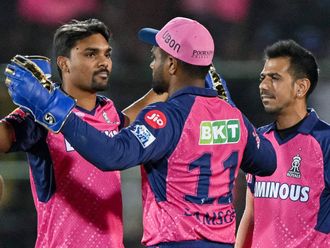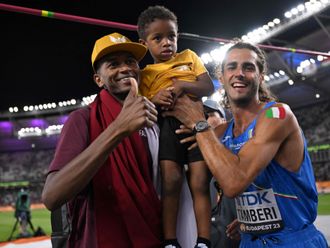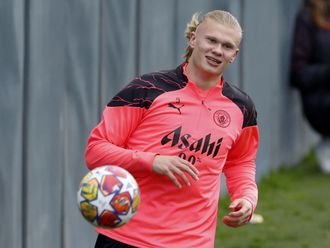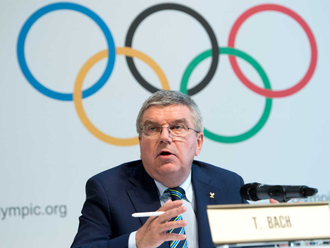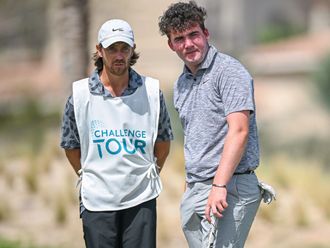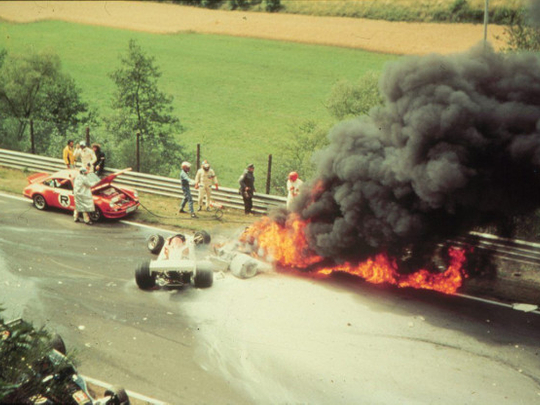
Dubai: While the greatest bugbear of Formula One drivers in the modern age is the poor quality of tyres, the racers of the 1970s were forever angst-ridden about a far more extreme concern – that of whether they would finish a grand prix alive.
For this was a decade when nine F1 drivers perished due to treacherous race tracks and their ill-equipped vehicles which could, at any given moment, turn into virtual coffins on wheels if those driving them committed a fatal mistake or suffered an unexpected mechanical failure at ludicrous speeds of up to 300 kilometres an hour.
The brutal reality for the daredevil drivers of that era was simple: Become inured to the fact that the Grim Reaper could always be lurking insidiously around every bend and, as the cliche goes, live every day as if it could be your last.
Three-time F1 world champion Niki Lauda, the subject of a recently released film ‘Rush’ about his infamous brush with death and thrilling battle for supremacy with late British rival James Hunt in the mid-to-late 1970s, provided a chilling glimpse into this fear-filled age to Gulf News in an exclusive telephone interview.
He said: “In Formula One at that time, every year at least one guy was getting killed right in front of you, then you think: ‘S***, what’s happening here?’. Then you have to find a way to cope with the threat of death, because the circuits were too dangerous, the cars were not strong enough and the cars caught fire; you cannot compare it to today. To drive and win a race like [current world champion] Sebastian Vettel does, there are the same problems as in the old days, but the pressure of getting killed or thinking about it does not exist. What I did was, whenever there was an accident, I went there myself being the spokesman of the drivers to find out exactly what happened and found a way to say myself: ‘I’m not going to make the mistake that guy did’. I made sure the wheels were locked on [on my car] and that was my way of coping with the danger – and I was very successful at this.”
To offset this constant climate of terror, drivers partied as hard and as fast at night as they drove during the day, Lauda admitted.
Indeed, as ‘Rush’ depicts – which Lauda says is a portrayal ‘identical to that time’ – his nemesis Hunt was emblematic of a decadent decade in F1, the caddish, charismatic Englishman knocking back a scotch and smoking marijuana ahead of a race.
Then, intoxicated with the heady relief of finishing a grand prix alive, he and other drivers would have no qualms about living the high life in the company of copious amounts of alcohol and an endless stream of female admirers.
“The problem is, we knew we could live a short life and the people driving at the time knew what they were getting into,” Lauda said, when asked about this full-throttle ethos. “Therefore we lived differently, because we already had this thought that life could end quickly, but we wanted to be in it and we wanted to take the chances. I partied, but I was not as bad as Hunt. He did it the whole week and I only did it on Sunday and Monday after the race. I knew if I partied before the race, I’d put myself in more danger, so I never did that.”
Yet despite his unswerving, studious dedication to his craft and strenuous efforts to avoid being another statistic in the grand prix graveyards, Lauda was perilously close to ending up on the road to oblivion himself.
On August 1, 1976, on the second lap of the German Grand Prix at the notoriously unsafe Nürburgring track, Lauda’s Ferrari suffered a suspected rear suspension failure, causing him to crash into an embankment, career into the path of fellow driver Brett Lunger’s Surtees-Ford car and burst into flames.
In the ensuing blaze, Lauda, who had won the F1 championship the previous year, suffered severe burns to his head and inhaled hot toxic gases that damaged his lungs and blood.
After emerging from a coma, he suffered the horrific ordeal of having to have his lungs vacuumed to remove the toxins he had inhaled.
And if that was not traumatic enough, given that the Austrian was wearing a modified helmet, the foam inside it had compressed and it dripped off after the accident, leaving his face exposed to the flames and causing him to suffer extensive scarring to his head.
The majority of his ear and hair on the right side of his head was lost, while Lauda also had to have reconstructive surgery to replace his eyelids so they could open properly.
Lauda, who is now a Formula One pundit for German television and a non-executive chairman of Mercedes, said he cannot remember anything about the actual crash, however.
But what is indelibly imprinted on his mind is the unbearable torture he endured while lying in hospital which, at one point, became so extreme that Lauda feared his time was up.
The 64-year-old, who founded and ran two airlines (Lauda Air and Niki) on retiring from the sport in 1985 after winning the F1 championship for a third time in 1984 with McLaren, recalled: “There was a moment when the overload on my body and the pain got so hard that basically I saw myself falling back into a big hole and it was a kind of relief. Then I really got frightened because I thought: ‘S***, you’re gonna die now. Do something.’. I was listening to the doctors and trying to keep myself awake and not letting the body go.”
Those tending to the stricken driver also feared the worst, so much so that he was asked by a nurse if he wanted a priest to come and read his last rites. In desperation at being on the threshold of extinction, Lauda agreed.
“I thought God could help me maybe,” he said. “Then he [the priest] didn’t talk to me at all. He just touched me. He never talked to me and then I really got upset because I expected him to speak to me. He was not aware that I was conscious. So he gave me my last rites without talking to me and then I was really annoyed. I thought: ‘Now I am sure I am not gonna die’.”
The road to recovery would be strewn with further hurdles to surmount, though.
Firstly, witnessing his disfigurement for the first time came as an understandable shock, as Lauda revealed: “A nurse asked me after 10 days if I would like to look in the mirror. I said: ‘Sure, why not?’. And I really had a shock when I looked. I thought: ‘What can I do now?’. And in the end I could not do anything; I had to accept it.”
Another considerable trauma – the excruciating nature of which is strikingly portrayed in one of the standout scenes of Rush – was when Lauda first attempted to put his driver’s helmet on over his fire-ravaged head when he had resolved to race again.
“The biggest problem I had after recovering was to try and put my helmet on over my right ear, which was badly burned, with nerves sticking out,” Lauda said. “My physical trainer had to modify the helmet was that the ear was better protected and the helmet was not shaking during racing.”
In the meantime, his great rival Hunt had cut Lauda’s lead in the championship race to just two points after the bed-ridden Ferrari driver had missed the grands prix in Austria and the Netherlands.
Lauda admits he watched the action from his hospital bed as his recovery gathered pace, fuelling his desire to make an improbable comeback.
But ever the arch pragmatist, he gave great thought and consideration to the implications such an incredible and potentially life-threatening move could engender before he decided to resume his career.
He said: “When I was fit again, or more or less fit, I asked my trainer and my doctors if my was body ready to think of a comeback. When they told me ‘yes’ then I sat down with myself and said: ‘Do you want to do it again after such a horrific experience or don’t you?’. What was clear was that I always wanted to make a comeback because I always knew it was dangerous and I was lucky anyway to stay alive and therefore my next challenge was How do you do a comeback and how difficult is it? I was fearless before the accident. I was never frightened, otherwise I could never have done Formula One racing. Fear was not really a problem to me at any time.”
However, this did not hold true in the early stages of Lauda’s return to the sport.
For, despite possessing almost superhuman courage and fortitude, Lauda is no Austrian automaton, and he admits even he was paralysed by panic when he was back behind the wheel as he prepared for the Italian Grand Prix.
“I did a test in Fiorano three days before Monza to see if the helmet hurt and if I could drive and get used to the car,” he revealed, recalling his bewildering return to action just 42 days after nearly losing his life. “When I came to Monza, the pressure building up to race was so great on the Friday before the race that I could not cope with it anymore. So I had to stop, get out of the car and try to analyse what happened. So I said to myself: ‘You’ve put too much pressure on yourself. Get in the car on Saturday in qualifying for the grand prix and drive around as if there is no race’. Slowly I got quicker and quicker, I could handle the car better and I was in control of the car. Then I was surprisingly fourth quickest [in qualifying] and quickest of the Ferraris and then my confidence came back.”
Lauda matched this performance in jaw-dropping fashion in the race itself and, two races later in the United States, he came third to put him three points ahead of Hunt going into the finale in Japan.
There would be no Hollywood ending to this unfathomable triumph over adversity, though, as the motorsport gods would cruelly conspire against him.
Torrential rain flooded the Fuji Speedway track, causing Lauda and some of his fellow drivers to protest vehemently for the race to be called off due to the treacherous conditions.
Their passionate pleas were ignored, though, but after the second lap of the race, Lauda refused to put himself at risk any longer and retired.
In ensuring he preserved himself from danger, Lauda allowed Hunt to claim the world championship crown by just one point as the Briton, needing only a fourth-place finish following his rival’s retirement, came third.
Would Lauda have carried on had he not had a near-fatal accident earlier in the year?
He said: “I maybe would have raced, I cannot tell you now, but it was a ridiculous situation. The circuit in Japan was flooded. The race was delayed because it was impossible to drive. At 4pm in the afternoon, the race director came and said that we had to start the race at 6pm due to television. I said to the race director: ‘But the circuit is as flooded as it was before. How can you take a stupid decision like this?’. I was told it was because of television. This was for me so ridiculous that I did not race and five others did not as well for the same reason.”
That unforgettable chapter of his legendary career is now immortalised on film, “a real good movie”, according to Lauda.
The Austrian, who comfortably reclaimed the title from Hunt in the season after his accident, said: “Two things struck me when I was watching it: The hospital scenes, when you lie there as a patient fighting for your life, when you see it from the other side, it moved me to see my ex-wife’s reaction as it looked very traumatic. And the other thing was I was upset after the accident how people treated me and saw me. When they saw me with my burns, they looked frightened and upset. When I saw the movie, I now understand why they looked so shocked.”


